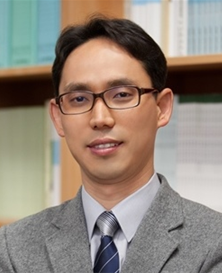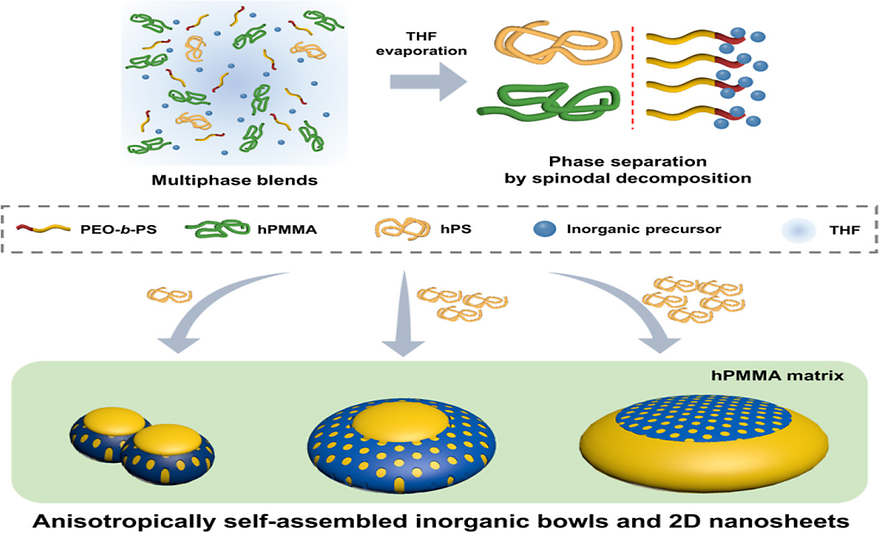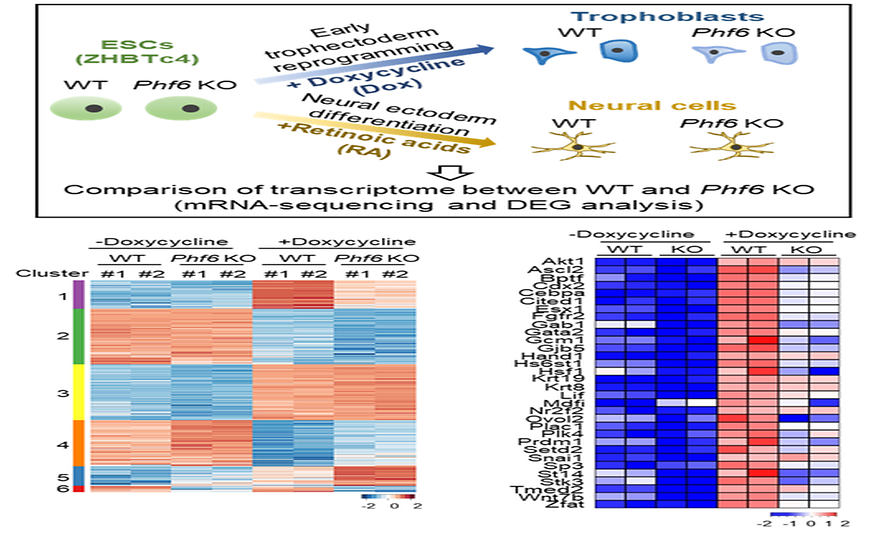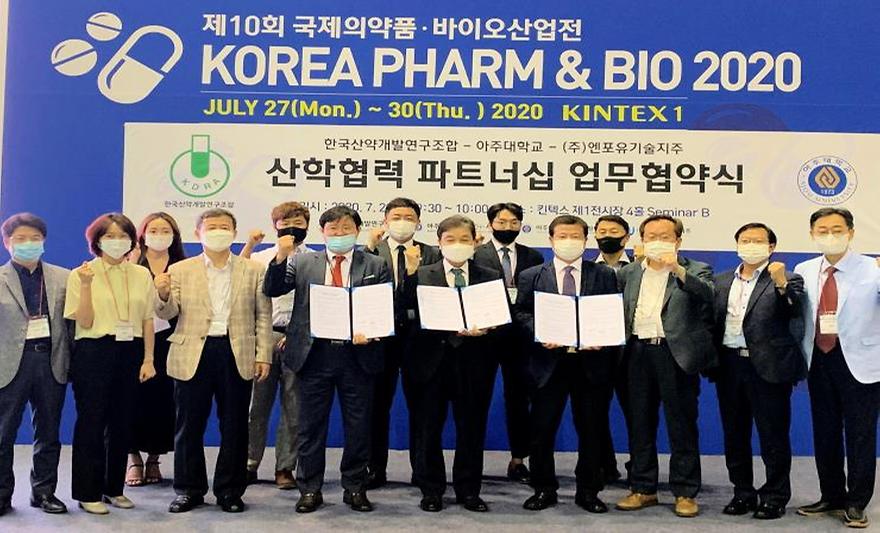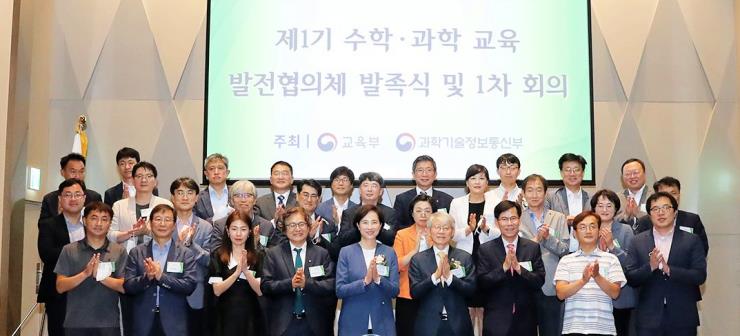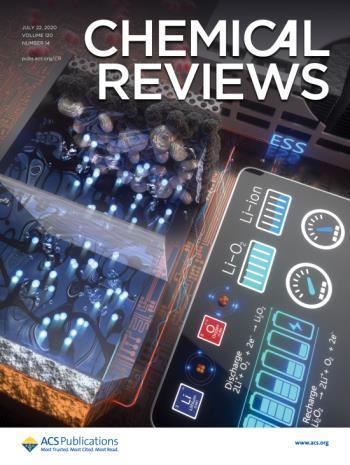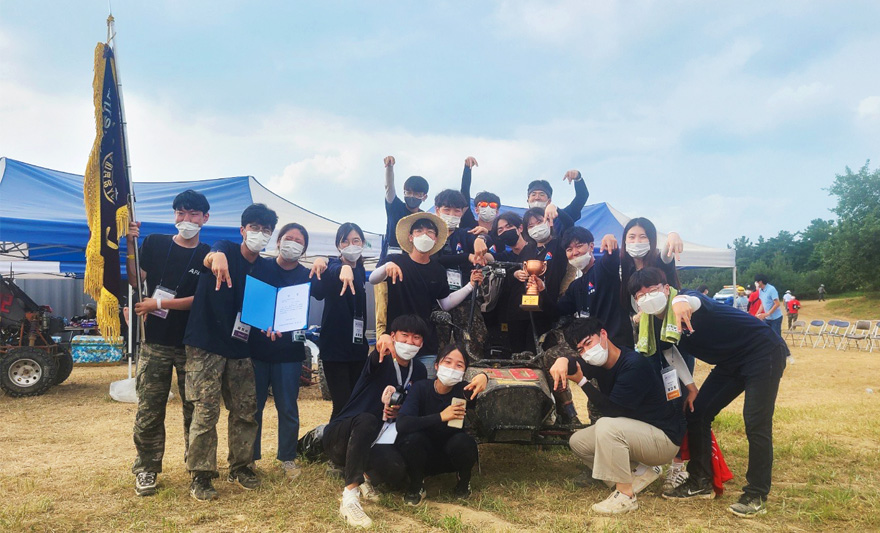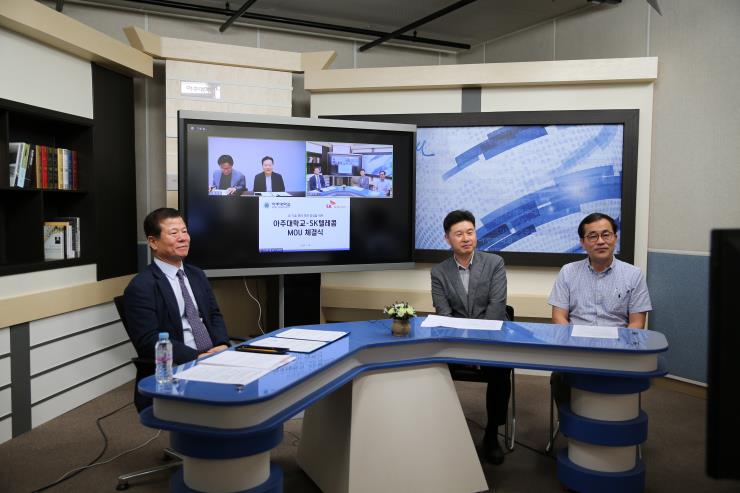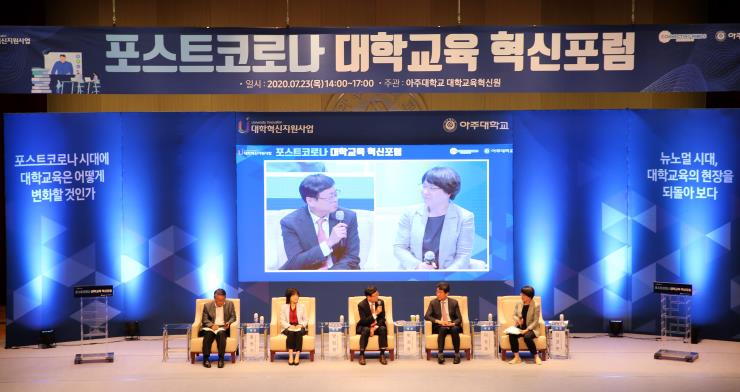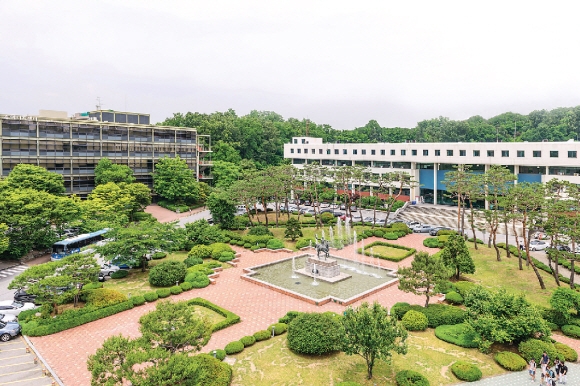-
A team of Ajou scientists has developed a near infrared ray (NIR) photodetector capable of detecting deterioration and damage in human muscle structures. The new device is expected to have many applications, including medical imaging equipment that requires highly sensitive and efficient sensors.The team, led by (Dept. of Materials Science and Engineering / Graduate Dept. of Energy Systems, pictured), has developed a new image sensing device using alternating current photovoltaic effects, which offer high detectivity and rapid rise/decay time. The development was introduced in an article entitled, “Broadband alternating current photovoltaic effect: An application for high-performance sensing and imaging body aches” in the August 29 online issue of Nano Energy (IF = 16.602). The team includes Prof. Park Ji-yong yong (Dept. of Physics / Graduate Dept. of Energy Systems Research), Prof. Kim Sang-wan (Dept. of Electrical and Computer Engineering), and Dr. Mohit Kumar (first author).Photodetectors, which convert light into electric signals, have so far been associated with solar energy cells. But these devices have much broader application, as they are essential not only in new and renewable energy, but also smartphones, the Internet of Things (IoT), and optical communications. Lately, there has also been growing interest in developing medical applications as well, as photodetectors can help make diagnosis and ongoing monitoring of patients far easier. Industries and academia alike have been particularly interested in photodetector technology that can facilitate the imaging of damage to muscles inside the human body. Photodetectors are already being used in assessing patients with advanced-degree burns.Photodetector researchers, in turn, have been paying attention to NIRs, as they are expected to minimize further damage to the body by light and enable the detector to sense at greater depths of internal tissues and organs. As a result, there has been great demand for high-performance photodetectors capable of detecting even the slightest changes in NIR signals. Such photodetectors would also have to be highly energy-efficient to be installed on portable medical diagnostic devices.Compound semiconductors have been the typical choice for NIR-based photodetectors so far. These compound semiconductors, including gallium-arsenic, however, are quite expensive, have low levels of detectivity in the NIR range, and have not performed well thus far. Most critically, they fail to have the high level of detectivity necessary for medical devices to identify and image damage inside the human body.Prof. Seo’s team has sought to overcome this by laying a quality titanium oxide (TiO2) nanofilm onto a silicone (Si) substrate and controlling the surface characteristics. The researchers have also succeeded in developing a photodetector structure that maximizes optical responsivity using silver nanorays. As a result, the team was able to create a high-performance photodetector promising a much higher switching ratio (≈1E4), detectivity (≈1E11 Jones), and response time (~ 120 μs) than available today. The resulting photodetector is superior in all areas of performance over the NIR photodetectors available today.The alternating photovoltaic current enables the photodetector to generate energy from the rapidly flickering incident rays on its own, eliminating the need to connect it to an outside power source. The photodetector, moreover, generates photovoltaic currents that are nearly 39,000 times greater than direct photovoltaic currents typical of solar cells, making it very well-suited to medical imaging.Prof. Seo’s team has also identified the operating mechanism of the photodetector using Kelvin probe force and electrostatic force microscopy. The alternating incident rays generate inhomogeneous absorption-induced imbalanced carriers inside the semiconductor. The resulting quasi-Fermi level splitting and realignment, the researchers demonstrated, ensures fast response and high detectivity by the photodetector.Prof. Seo: “We successfully imaged internal changes in the muscular tissues of the fingers by scan-imaging them with our photodetector.” He explained, “With this device, we will be able to detect [the locations of] body aches and pain and image them at ultra-high speed. We expect the photodetector will be applied to scanning and diagnosing various other types of changes occurring not just in muscles, but in other parts of the body as well, particularly for pediatric patients.”The team’s research project was made possible in part thanks to the Program for the Future New Material and Original Technology Development Program and the Basic Research Support Program for Experienced Researchers, both from the Ministry of Science and ICT and the National Research Foundation of Korea. A patent application on the invention is now pending.
-
454
- 작성자OI***
- 작성일2020-11-02
- 3713
- 동영상동영상
-
A team of researchers including Ajou’s own Prof. Hwang Jon-kook (Department of Chemical Engineering) has developed a new original technology for controlling the shapes of porous nanomaterials. The team’s discovery is expected to help solve current roadblocks to innovation in various fields, including secondary cells and energy storage systems, as well as energy, catalysts, environmental engineering, and medicine.The article, listing Prof. Hwang as the principal author, was published in the August 12 online issue of Science Advances (IF = 13.116, JCR 4.93%), a sister publication of Science. Dr. Kim Seong-seop and Prof. Lee Jin-woo of the Korea Advanced Institute of Science and Technology (KAIST) were also on the team.The title of the article reads: “Polymer blend directed anisotropic self-assembly toward mesoporous inorganic bowls and nanosheets.”The team has developed a new mechanism which can easily control the shapes of molecules and nanostructures by simply combining and heating an organic polymer blend and an inorganic metal oxide precursor. Furthermore, the team demonstrated that the dish-shaped niobium oxide created by applying their method offers the highest-possible levels of performance and safety when used as an anode for a potassium ion battery, which garners attention as a potential material for next-generation secondary batteries.Researchers worldwide have so far sought to control the shapes of porous materials through complex and often expensive methods. These methods, however, failed to ensure precise and efficient control of porous nanostructures and particles. Accordingly, there has been growing demand for a new technique that is simpler, less expensive, and more capable of controlling all relevant factors, including size, structure and shape of pores.Prof. Hwang’s team found a solution in the self-assembly effect of multicomponent polymer blends. Multicomponent polymer blends can assemble themselves into complex and sophisticated nanostructures when certain conditions are met. Although this mechanism has long been known in polymer physics, few actual applications have been made out of it.Prof. Hwang’s team established a design guideline that brings together the self-assembly mechanism of multicomponent polymer blends with inorganic material chemistry, and the result—the anisotropically self-assembled particle (ASAP)—was thus born, promising simple and easy ways to control nanostructure, chemical composition and shape of porous materials.Prof. Hwang explains: “Our work is significant in that it demonstrates, for the first time, that self-assembling polymer blends can be used to solve the problem with synthesizing porous inorganic materials.” He adds, “This means that we can now pioneer new fields of interdisciplinary research that connect polymer physics and inorganic material chemistry.”As a nanoenergy and material specialist, Prof. Hwang has long been researching ways to control the structures and shapes of porous nanomaterials. His future research plans include finding simple methods for synthesizing inorganic porous materials and producing customized designs for electrodes of next-generation secondary batteries.*Pictured: A diagram of ASAP, a porous inorganic material using the self-assembly of a multicomponent polymer blend.
-
452
- 작성자OI***
- 작성일2020-09-21
- 4833
- 동영상동영상
-
A team of researchers with the participation of Ajou Professor Park Dae-chan (Department of Biological Sciences) has found a new clue to preventing disruptions to the placenta, vital to fetal growth and nutrition. The team’s discovery of a new factor critical to placental development is expected to catalyze development of new solutions to ensure early fetal health.The team’s article, published in the July 31 online issue of Nucleic Acids Research (Impact factor: 11.501, IF% = 4.882), was entitled, “The chromatin-binding protein PHF6 functions as an E3 ubiquitin ligase of H2BK120 via H2BK12Ac recognition for activation of tophectoderman genes.” The team also included Prof. Baek Sung-hee of Seoul National University and Prof. Lee Ji-min of Kangwon National University.The team discovered the importance of an epigenetic factor known as PHF6 in the trophectoderm of the blastocyst in placental formation. Blastocysts are sphere-shaped bundles of cells that contain embryonic stem cells, surrounded by trophectoderms. Trophectoderms form the embryo and the placenta, and how epigenetic factors regulate trophectodermal differentiation has not been understood until now.Based on an mRNA-sequencing genomic analysis, an emerging method for analyzing nucleic sequences, Prof. Park’s team discovered that embryonic stem cells from which PHF6 was removed led to disruptions in the formation of blastocysts and the placenta.PHF6 is an epigenetic factor protein that recognizes histone modifications. The team found that PHF6, by recognizing the chemical modifications (acetyl group) to histone proteins surrounding DNA, additionally binds ubiquitin to the histone. In other words, the researchers confirmed that histone modifications by PHF6 is what regulates the expression of trophectodermal genes in blastocysts.The team explained: “We have demonstrated that it is possible to modify the placental developmental process epigenetically using histone proteins that are dissolved and resynthesized in just days, instead of modifying the DNA nucleic sequences transmitted down the generations.”The research was made possible with the help of the Ministry of Science and ICT (MSIT) and the National Research Foundation of Korea (NRF)’s Leading Research Support, Individual Basic Science and Engineering Research, and New Researcher Support Programs.
-
450
- 작성자OI***
- 작성일2020-09-21
- 5221
- 동영상동영상
-
Ajou University continues to diversify its learning programs to help educate and train leaders for the future of artificial intelligence (AI). Having added the departments of AI and AI education to the General and Education Graduate Schools, the University has also opened the Department of AI Convergence for undergraduates, and will start recruiting compound majors and minors in the fall semester.The new Department of AI Convergence will offer an interdisciplinary curriculum designed to respond to the growing demand from industry for AI and big data specialists. Students who join the new department for their compound major or minor requirements will learn the basics of AI and data and develop problem-solving skills using software and AI. The new education will equip them with the skills they need to find satisfying careers in IT and software, and a host of other fields where AI is playing an increasingly important role, such as medicine, finance, social services, education, robotics, and disaster management.Every semester, starting this fall, the new department will accept 50 students already enrolled in the University. Applications will be received from August 5 to 12.With governments, companies, and schools worldwide engaged in a fierce race to develop competent AI workforces and technologies, Ajou has been among the earliest in Korea to seize on AI as an important subject of education, adding new AI-centered programs to the Education and General Graduate Schools. The Department of AI at the General Graduate School provides integrated postgraduate degree programs on core topics of AI, including deep learning and machine learning, and will also begin accepting students in the fall semester.The AI Education major at the Graduate School of Education with support from the Ministry of Education’s AI Convergence Education Capability Enhancement Program for Teachers. Working teachers who participate in this program will obtain master’s degrees and go on to teach all AI-utilizing subjects at actual schools. This department, too, will begin recruiting and accepting students in the fall semester.The AI education program will consist of two tracks: AI education and AI convergence education. The former will provide in-depth courses on AI theory, mathematics- and software-based AI education, and other such subjects teachers need to teach their students. The latter will focus on specialized AI-based pedagogics.
-
448
- 작성자OI***
- 작성일2020-09-21
- 4720
- 동영상동영상
-
Ajou University has recently entered a series of agreements designed to enhance the partnership system for fostering campus-based tech startups.On July 24, Ajou signed a memorandum of understanding (MOU) with Korea Bio Investment Partners [KHTC1](KOBAI). Parties to the memorandum included the University’s Start-up Support Foundation and the Industrial-Academic Cooperation Center as well as N4U Tech Holdings Incorporated. Attending the signing ceremony were Oh Yeong-tae, head of both the Industrial-Academic Cooperation Center and the Start-up Support Foundation; Lee Gi-chil, CEO of KOBAI; and Kim Su-dong, executive director of N4U.Through the memorandum, the parties agreed to work together in supporting tech startups through initial and follow-up investment, entrepreneurial training, sustainable growth strategies, and global expansion; developing programs for fostering entrepreneurship and job creation in advanced industries, including biotechnology and artificial intelligence; promoting exchange between members through a committee to be established; and sharing existing infrastructure, such as the University’s makerspace, for policy projects.KOBAI is a new investment company specializing in early investment and customized entrepreneurial support for tech startups in Korea and abroad, and focuses on advanced industries, particularly biotechnology and artificial intelligence.Mr. Oh remarked: “This is a significant moment as Ajou University is the first government-registered technology accelerator to partner with KOBAI, particularly with the goal of facilitating innovation in biotechnology and healthcare, two of Ajou’s core areas of focus today.” He went on, “We at the University will continue to recruit new investors and expand our network of investment in order to establish a specialized and highly advanced system of collaboration between the Start-up Support Foundation, the Industrial-Academic Cooperation Center, and N4U, toward maximizing partnership synergy.”Another MOU was signed between Ajou’s LINC+ Group, Start-up Support Foundation, and N4U, on the one hand, and the Korea Drug Research Association (KDRA), on the other, on July 29, for the joint management of a biotechnology and healthcare project.The MOU emphasized collaboration over fostering startups in biotechnology and healthcare and recruiting investors for them; supporting business-tailored projects and technology transfers; working together on providing industrial-academic collaboration-based education and training (on-the-job and entrepreneurial alike) to develop a highly skilled workforce; increasing cooperation in the form of joint research and marketization; and promoting exchange between members through a committee.The signing ceremony was followed by Prospective Biotech Startup Investment Forum [KHTC2]2020, which highlighted opportunities for partnership between Korean investors and prospective biotech startups.Ajou’s LINC+ Group, Start-up Support Foundation, and N4U Tech Holdings, which together have undertaken the COVID-19 Rapid Call Project, also took on the task of recruiting prospective startups deserving of investment. Eight Ajou-affiliated enterprises, including Cell & Bio Inc., introduced their technologies at the forum and networked with investors. The COVID-19 Rapid Call Project encompasses all initiatives by Ajou towards enhancing collaboration between businesses and local communities to mount effective responses to the current pandemic.
-
446
- 작성자OI***
- 작성일2020-09-21
- 4570
- 동영상동영상
-
Park Hyungju, President of Ajou University, has joined the Committee on Development of Mathematics and Science Education (CDMSE), a public-private partnership launched by the Ministry of Education (MOE) and the Ministry of Science and ICT (MSIT) to look for ways to innovate STEM education in the post-pandemic age.The committee held an inauguration ceremony and first meeting on July 29 and consists of 27 members—all experts from education, research and industry, with Mr. Park appointed its inaugural chair. The first term of the committee will end in June 2021.Attending members watched video clips showing interviews in which students share their thoughts and wishes regarding mathematics and science education. Measures were then discussed on enhancing collaboration between the two ministries on matters of education, particularly focusing on ways to identify and implement collaborative tasks for a new model of mathematics and science education that encourages deep thinking in students.Actions under discussion included establishing intelligent labs on campuses to provide forward-looking AI classes on mathematics and science through experience, developing new learning programs centered on core concepts of the intelligent future (e.g., robotics, aerospace), and establishing a “Star Bridge Center,” Which will serve as a hub for collaboration between schools and specialized research institutions and help develop education and training content and programs.The measures discussed by the committee will be implemented by the end of this year, with both ministries pledging to develop specific measures to enhance collaboration. The committee’s second term will begin in the latter half of next year, with members focusing on developing specific mid- to long-term tasks for collaboration based on ideas shared in the first term.
-
444
- 작성자OI***
- 작성일2020-09-21
- 3956
- 동영상동영상
-
A cover image of Chemical Reviews. ©ACS Publications.An article by a team of international researchers, which included Professor Kwak Won-jin (Department of Chemistry/Department of Energy System Research (Graduate)), was published as the cover article for the July 22 online issue of Chemical Reviews.The article, for which Prof. Kwak is a principal author, concerns lithium-oxygen batteries, a next-generation secondary battery system garnering attention worldwide. The team of researchers included Prof. Sun Yang-kook of Hanyang University, Korea; Prof. Doron Aurbach of Bar-Ilan University, Israel; Prof. Peter Bruce of the University of Oxford; and Prof. Linda Nazar of Waterloo University, Canada. Chemical Reviews, published by the American Chemical Society (ACS), is the top-ranked journal in the entire field of chemistry.In the article entitled “Lithium-Oxygen Batteries and Related Systems: Potential, Status, and Future,” Prof. Kwak and his colleagues introduce the findings of their years-long research into the structure of the lithium-oxygen battery, its working mechanism, and related derivative systems. The researchers also discuss the core issues and recent trends in research on the lithium-oxygen battery, and needed practical improvements.A next-generation secondary battery system capable of utilizing oxygen in the air as fuel, the lithium-oxygen battery holds the potential to surpass the theoretical energy density limit of the lithium ion battery used in electric vehicles. Research has abounded on the topic as a result, but there are also considerable obstacles that compromise its commercial viability, such as its short lifecycle as a side effect of reacting with oxygen, its low energy efficiency due to the inevitable creation and dissolution of byproducts. Innovative solutions to these problems are needed.Prof. Kwak explains: “It is exceedingly difficult to improve the lithium oxygen battery’s energy efficiency and reversibility to a viable level, as there are a number of complex factors involved,” adding, “But, insofar as the demand for high-energy-density battery systems continues to grow, we should continue rising to the challenge.”Prof. Kwak will continue his research on the lithium oxygen battery in his new faculty position in the Department of Chemistry at Ajou University, where he was appointed in the spring semester. He has published a number of articles in this year, addressing issues with the lithium oxygen battery and possible solutions.
-
442
- 작성자OI***
- 작성일2020-09-21
- 4166
- 동영상동영상
-
AFA, Ajou University Club from the Department of Mechanical Engineering, recently won overall first place at 2020 Baja Society of Automotive Engineers KOREA at Yeungnam University. The Baja SAE KOREA which was held from August 19 through 22, was a competition that features cars designed by university students. The Baja SAE Korea began in 1996 and celebrated its 25th anniversary in 2020.15 teams from 13 universities across the country participated in the competition. The off-road vehicle produced by each team was assessed in four categories: static test, brake test, dynamic force check, and durability test, and the team with the highest total scores from each category will win the championship.Ajou University A-FA team (advisory professor: Jeon Yong-ho) has won the first place with the top scores in all categories. The defining feature of A-FA’s car was the rear semi-trailing arm optimized for self-made vehicle. The fact that students can pick up their own gearboxes by deriving the desired gear ratio with a simulator for calculating longitudinal deceleration also contributed to their excellent performance.“I’m very happy to receive this award, 19 years after winning the last championship in 2001,” said Kim Hyo-chan, the leader of the A-FA team. “I think we were able to make it because the team members did their best despite the poor working condition due to COVID-19.”The team A-FA stands for “Ajou Future Automobile.” Founded in 1993, the A-FA has been participating in all kinds of competitions with various vehicles, including on- and off-road vehicles entirely designed and manufactured by students themselves. In 2019, A-FA won the first prize in the off-road vehicle category in “2019 KSAE Self-made Car Competition”
-
440
- 작성자OI***
- 작성일2020-09-10
- 4534
- 동영상동영상
-
* Self-powered wearable module for diagnosing livestock health, developed by a team of Korean and Australian researchers* Joint research by Korean and Australian researchersA team of researchers led by Professor Kim Jong-hyun (Department of Applied Chemistry and Biological Engineering/Graduate Department of Molecular Science and Technology), working together with a team of Australian researchers, succeeded in developing the core technology for a self-powered wearable module for diagnosing livestock health. The technology is expected to aid in the development of a cutting-edge digital platform that allows large livestock farmers to diagnose and manage the health of their livestock in real time.The results of the research collaboration, entitled “Investigation of Low-intensity Light Performance of Kesterite CZTSe, CZTSSe, and CZTS Thin-film Solar Cells for Indoor Applications,” were published on the online issue of Journal of Materials Chemistry A (IF = 11.301, JCR top 6.7%) on July 21. The authors include researchers from Ajou University, the Green Energy Institute, Chonnam National University, and the University of New South Wales.The researchers discovered the mechanism of a CZTSSe-based solar cell that can be used in a variety of low-light settings. CZTS-based thin-film solar cells are affordable and eco-friendly light absorbers, and are expected to lead to the development of a better alternative to existing solar cells, which are expensive and made of environmentally harmful heavy metals. Although CZTS-based solar cells have been known to boast superior conversion efficiency in outdoor settings with abundant sunlight, little research has been done on how effective they are in low-light settings, such as overcast weather and indoor environments.The researchers thus set out to develop a CZTSSe film that could be used in a variety of low-light environments, and proved that such film could produce enough electricity to run Internet-of-things (IoT) sensors even in low-light settings. In other words, their CZTSSe thin-film solar cell demonstrated the capability for application to self-powered IoT sensors of various types used in either indoor or outdoor settings.Timely and accurate diagnosis and projection of livestock diseases, including swine fever and foot-and-mouth disease (FMD), based on efficient monitoring is crucial to the containment of contagious animal diseases as well as the welfare of animals. Members of Professor Kim’s team have been working together on multiple projects over the years to develop effective livestock health monitoring systems through collaboration with industries and academic institutions worldwide. The team has included members from Ajou University (Professor Kim), Chonnam National University (Professor Kim Jin-hyeok), Korea Electronics Technology Institute (Dr. Kim Jin-cheol and Dr. Park No-chang), Green Energy Institute (Dr. Park Jong-seong[KHTC1]), Daeyeon C&I Inc., and University of New South Wales and University of Queensland, both in Australia.This global team has been searching for ways to create a wireless, standalone power system that can reliably supply electricity irrespective of the differences in livestock farming environments. Since developing a self-powered wearable module sensor for livestock health assessment, the researchers have been testing it in Australia.The key to making a device like this possible lies in a solar cell that can be used in both outdoor and indoor environments. To this end, the team first developed a perovskite solar cell with superior output, and published their study in Nano Energy, a widely cited academic journal, in February 2020. The team had also been researching encapsulation technology to ensure the actual applicability of the solar cell they developed, and had their findings published in Solar Energy Materials & Solar Cells in December 2018.Professor Kim explained, “We have developed a wireless, self-powered, wearable sensor module based on our earlier studies, and are now testing it on cattle on a farm in Brisbane. We plan to expand our trial to include large-scale farms in other regions of Australia.”The team regularly organizes their own meetings and exchanges to facilitate better understanding of the technological demands of large livestock farms in Australia and develop solutions accordingly. A leader in advanced livestock and agricultural technologies, Australia has a significant stake in developing reliable solutions for diagnosing livestock health so as to help farmers protect and increase their income. The researchers are now planning to expand the scale of their experiment in Australia with additional support promised by the city of Narromine and its mayor, Craig Davies, in New South Wales.Professor Kim remarked, “When we succeed in developing the final product based on our wearable livestock health diagnosis module, it will very likely find a welcoming market in the Australian livestock industry. We intend to add the big data from our continuing trials and the AI-based model of analysis we are developing to our study and build diagnostic and monitoring platforms by country and livestock species.”The team’s research has been aided by the International R&D Collaboration Program (P0006857) of the Ministry of Trade, Industry and Energy and the Korea Institute for Advancement of Technology, as well as the Korea-Oceania Collaboration Infrastructure Development Program (NRF-2018K1A3A1A17081404) of the Ministry of Science and ICT and the National Research Foundation of Korea.
-
438
- 작성자OI***
- 작성일2020-08-10
- 7644
- 동영상동영상
-
-
436
- 작성자OI***
- 작성일2020-08-10
- 6684
- 동영상동영상
-
Ajou University organized the Post-COVID-19 University Education Innovation Forum and supported debates on how university education should change in the post-pandemic future.Organized by the Ajou University Center for University Education Innovation, the forum was held online, starting at 2 p.m. on July 23 and broadcast via YouTube livestream.Assistant Dean Paul Kim of the Stanford Graduate School of Education was featured as the first keynote speaker, sharing his ideas on post-pandemic education innovation. Kim spoke about how Stanford University has been responding to COVID-19, and what it could imply for the future direction and strategy of higher education.Forecasting that the future of education will be more “coaching” than “teaching,” Kim stressed the need to develop a curriculum that takes into account the differences in interests and capabilities among students and seeks to maximize students’ potential.”Kim also discussed the Stanford Mobile Inquiry-Based Learning Environment (SMILE), emphasizing that genuine study and academic exploration involves raising bold questions and relentlessly debating them. He argued that future leaders enroll in university not for the degrees but out of empathy and devotion, with a willingness to learn and experience so that they can change the world.In order for this kind of education to be possible, Kim emphasized, the culture of educational institutions should first be changed in innovative ways. He stressed the need for “culture engineering” based on strong leadership and organization, citing Google as an example of successful culture engineering.Lee Ju-ho, professor at the KDI School of Public Policy and Management and former Minister of Education, shared his thoughts on AI revolution in education and the destructive innovation of universities as the next keynote speaker. Professor Lee predicted the rise of education customized to the needs of individual students.Projecting that personalized learning will be made possible by the rise of “edutech,” led by artificial intelligence (AI), Professor Lee emphasized that teachers would also become learning planners.A series of presentations and panel discussions followed, featuring Park Hee-deung, head of the Budget and Planning Office and the University Innovation Support Program Group at Korea University; Yang Im-jeong, head of the Education Innovation Office at Pusan National University[KHTC1]; Hong Won-ki, head of the Innovation Center for Education at POSTECH; and Kang Kyung-ran, head of the Kang Kyung-ran, head of the Center for University Education Innovation at Ajou University. The speakers shared other universities’ examples of dealing with COVID-19 and its impact on education, such as: Korea University’s NeMo Class for online and offline lectures; Pusan National University’s PLATO, an online platform for knowledge-sharing; POSTECH’s virtual- and augmented-reality learning environment and real-time video-conferencing of lectures; and Ajou University’s “New Normal” education model and adaptive learning.In his greeting to the participants, President Park Hyung-ju of Ajou University explained that the forum was organized to share the “trial and error” of this year’s spring semester and prompt debates on the proper future direction of higher education in Korea. He expressed his wished that the forum would occasion reaffirmation of the role and utility of higher education and a gathering of likeminded people who share the same macro-level concerns.Paul Kim (Assistant Dean, Stanford Graduate School of Education)Park Hyung-ju (President, Ajou University)
-
434
- 작성자OI***
- 작성일2020-08-10
- 7153
- 동영상동영상
-
Having earned KRW 2.6 billion in revenue from technology transfers last year, Ajou University came in ninth among all universities compared nationwide.The rankings were announced as part of the Ministry of Education (MOE)’s University Information Disclosure in June 2020, which detailed how much Korean universities earned from technology transfers and related contracts in 2019. A total of 416 schools, including 224 universities, 147 vocational colleges, and 45 graduate universities, share information on 62 subjects in 14 categories (including school status, student body, faculty, and finance) through this disclosure.The annual revenue Ajou generates from technology transfers has been rising steadily, from KRW 1.18 billion in 2016 to KRW 1.96 billion in 2017, KRW 2.14 billion in 2018, and KRW 2.63 billion in 2019. The revenue consists of the money that businesses pay to the university in exchange for intellectual property rights to the research and development results of the university’s research teams.Ajou provides a great interdisciplinary research environment, as almost all of its colleges—Engineering, Natural Sciences, Medicine, Pharmacy, and Nursing—are located on the same campus, facilitating collaboration among researchers. Moreover, the university participates in a variety of policy grant programs that support the marketization of new technologies throughout the technology life cycle, from patent search to ownership transfer. Ajou has also continued to participate in the Bridge+ Program (MOE and National Research Foundation of Korea), Patent Gap Fund Program (Korean Intellectual Property Office and Korea Intellectual Property Strategy Agency), and Technology Management Consulting (TMC) Program [KHTC1](Ministry of Science and ICT and COMPA).In March this year, Ajou expanded the Technology Transfer Center [KHTC2]to create the Technology Marketization Division[KHTC3], staffing it with patent attorneys, technology transfer agents, and certified valuation analysts, to provide a comprehensive range of support for successful marketization.Technology Transfer Revenue Rankings, 2019RankUniversityRevenue (million KRW)1KAIST10,1832Seoul National University8,8353Korea University5,4194Sungkyunkwan University4,4725Kyung Hee University4,2716Yonsei University4,0487Hanyang University3,0398Pusan National University2,7219Ajou University2,63010POSTECH2,48011Kyungpook National University2,472Average nationwide: KRW 760 million* Source: MOE (June 2020), University Information Disclosure.
-
432
- 작성자OI***
- 작성일2020-08-10
- 7114
- 동영상동영상

